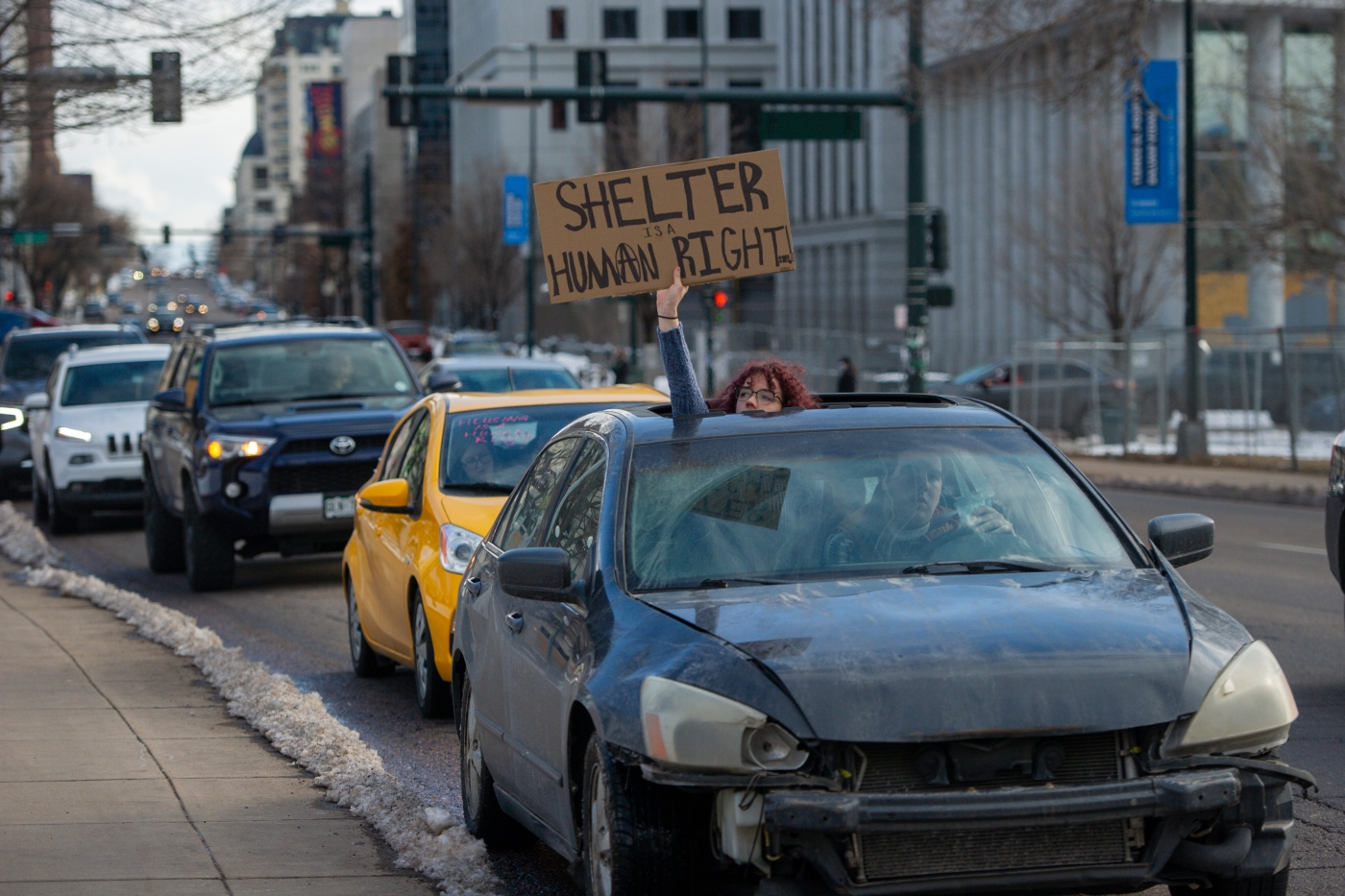Charlene Winn moved from the street to her Lowry apartment five years ago. It wasn’t a palace — a small kitchen and living room, her bedroom, the bathroom — but it was a home, her home. Winn had worked hard to get it: She’d spent four years unhoused, moving from resource to resource, searching for work and an apartment she could afford.
She found both, working part-time at Dollar Tree and living in an affordable unit a few blocks off East Colfax. Then the pandemic hit, and she lost her job. Her rent went up by $150, a sharp spike for someone on a fixed income, and her debt climbed.
“I couldn’t eat, I couldn’t sleep,” she said. “I couldn’t sleep because it was like — I feel like I was doing something I wasn’t supposed to be doing because how dare me sleep, I need to be up trying to do something to get the situation rectified. You can’t sleep with something on your mind like that.”
After she was served with a demand for unpaid rent, Winn was connected through a community group to the state’s emergency rental assistance program, which paid nearly $10,000 and covered her through November. She won’t need more beyond that: She’s caught up now, and the two new part-time jobs she works will cover her moving forward.
“I can wake up and go to sleep now and wake up knowing that I have somewhere to stay, that it’s going to be alright,” Winn said. “Winter’s coming, I won’t be out in the cold. When my grandkids visit, they have somewhere they can come in and sit.”
Winn is one of more than 34,000 households in Colorado who’ve benefitted from emergency rental assistance since the pandemic began. The state has spent more than $290 million in federal money to keep those residents housed, and local governments have doled out millions more.
But the funding is running out.
State officials estimate rental assistance will run out at some point in early 2023. Some local programs are already dry, like Aurora’s, and others, like Denver, are beginning to impose limits.
At the same time, state and local data show that evictions are returning to pre-pandemic levels. Since June, Colorado’s eviction filings are higher than they’ve been in nearly three years 2020: More than 3,000 evictions were filed in each of those months; that level hadn’t been reached since February 2020, state data shows.
Money is still available, and officials urged tenants in need to apply. But once it’s gone, there’s no way to replace it fully, state and local officials said. Federal pockets are far deeper than any here, and the protection that money offered — 18 months of rental assistance for qualifying households — cannot be replicated.
“Right now, we have unprecedented financial support for renters who are unable to meet their monthly rental obligations,” said Zach Neumann, the executive director of the COVID-19 Eviction Defense Project. “At some point early next year, that money will basically be used up and when that happens, one of the primary tools that we’ve had to stop evictions will be gone, and it’s not exactly clear what will happen after that.”
The prognosis shifts depending on whom you talk to. Neumann said that other states who’ve run out of rental assistance money have seen evictions go up after. Emily Goodman, who works for the East Colfax Community Collective to help tenants get housing aid and support, said the impact of the money running dry would be “unreal.”
But Drew Hamrick, a senior vice president of the Apartment Association of Metro Denver, cast those concerns as overblown. He said there had been repeated fears of coming “eviction tsunamis” during the pandemic, disasters that never materialized. What’s happening now, he said, is a return to the normal range of evictions, not a seismic shock to the system, and rental assistance money isn’t needed in the way it was during the worst of the pandemic.
But, as advocates noted, those previous warnings came when there was rental assistance available and a constellation of state and federal eviction moratoriums further shielding at-risk tenants. Hamrick countered that those happened in stutter-start increments and that evictions didn’t spike in the interim between programs.
“I suppose it’s fine for the people that think it’s fine to meddle with economies to sit back and say, ‘This is a result of all we’ve done,’” he said. “This is a slow, steady, methodical return to normal in housing markets, and that’s a very, very good thing.”
Other experts were less quick to move forward. Peter LiFari, who runs Maiker Housing Partners in Adams County, said the expiring rental assistance money “needs to be replaced.” Without it, he said, evictions will go up, and homelessness and displacement will follow. Some of the ground made during the pandemic will be lost.
Fully replacing it cannot be done on the local level, officials said. The state is doling out $15 million to $20 million a month in federal rental assistance, said Sarah Buss, who until Friday was the director of the state’s Office of Housing Recovery. State officials are hoping to find ways to provide that amount over the course of a year, rather than every 30 days.
The best replacement would be an additional infusion from Congress, officials said. But with President Joe Biden declaring the pandemic “over” and other COVID-related funding stalling in Congress, that route seems unlikely, too.
The situation is similar in Denver: The city’s been allocated nearly $49 million in total emergency rental assistance funds, said Melissa Thate, the city’s housing stability director. That’s “substantially more” than the city previously had to support similar efforts, she said. Though the availability of that money has meant the city’s existing rent and utility assistance program has been untapped, that program is funded at a fraction of the federal effort and offers shorter-term support.
State and local officials are instead looking at what to do with what they have. Denver’s expanding its eviction legal assistance program, Thate said, and eyeing other permanent programs. The state’s working “diligently” to replace current assistance, at least to some degree, Buss said, but nothing concrete has been developed yet. In Aurora, officials are looking at ways to provide more local support but are waiting to see the level of need, the city’s housing and community development manager said.
LiFari hoped the state could avoid a backslide. The various measures implemented since the pandemic began have helped and will likely help going forward, keeping evictions lower than they would’ve been.
“Overall, we’re in a better place than three years ago,” he said, “but where we were 3 years ago was so untenable.”
Join the Conversation
We invite you to use our commenting platform to engage in insightful conversations about issues in our community. We reserve the right at all times to remove any information or materials that are unlawful, threatening, abusive, libelous, defamatory, obscene, vulgar, pornographic, profane, indecent or otherwise objectionable to us, and to disclose any information necessary to satisfy the law, regulation, or government request. We might permanently block any user who abuses these conditions. As of June 15, 2022, comments on DenverPost.com are powered by Viafoura, and you may need to log in again to begin commenting. Read more about our new commenting system here. If you need help or are having issues with your commenting account, please email us at memberservices@denverpost.com.






